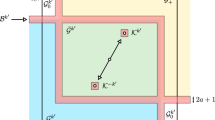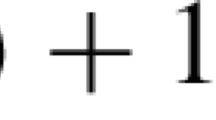Abstract
These notes concern existence, and suitable formulation, of meaningful conditions on the direction of the vorticity which guarantee the regularity of the solutions to the evolution Navier–Stokes equations. A main concern here is to compare the different situations which appear in considering slip and no-slip boundary conditions. The paper reviews mainly results obtained in some of the references cited.
Similar content being viewed by others
References
Beirão da Veiga, H.: A new regularity class for the Navier–Stokes equations in \({ R}^n\). Chin. Ann. Math. Ser. B. 16(4), 407–412 (1995)
Beirão da Veiga, H.: Vorticity and smoothness in viscous flows, in Nonlinear Problems in Mathematical Physics and Related Topics, volume in Honor of O.A. Ladyzhenskaya, International Mathematical Series, Vol. 2, Kluwer Academic, London (2002)
Beirão da Veiga, H.: Vorticity and regularity for flows under the Navier boundary condition. Comm. Pure Appl. Anal. 5, 907–918 (2006)
Beirão da Veiga, H.: Vorticity and regularity for viscous incompressible flows under the Dirichlet boundary condition. Results and related open problems. J. Math. Fluid Mech. 9, 506–516 (2007)
Beirão da Veiga, H.: Direction of vorticity and regularity up to the boundary. The Lipschitz-continuous case. J. Math. Fluid Mech., 55–63 (2012)
Beirão da Veiga, H.: Viscous incompressible flows under stress-free boundary conditions. The smoothness effect of near orthogonality or near parallelism between velocity and vorticity, Bollettino UMI, 9 V, 225–232 (2012)
Beirão da Veiga, H., Berselli, L.C.: On the regularizing effect of the vorticity direction in incompressible viscous flows. Differ. Integral Equ. 15, 345–356 (2002)
Beirão da Veiga, H., Berselli, L.C.: Navier–Stokes equations: Green’s matrices, vorticity direction, and regularity up to the boundary. J. Diff. Equ. 246, 597–628 (2009)
Berselli, L.C.: Some geometrical constraints and the problem of the global regularity for the Navier–Stokes equations. Nonlinearity 22, 2561–2581 (2009)
Berselli, L.C.: Some criteria concerning the vorticity and the problem of global regularity for the 3D Navier–Stokes equations. Ann. Univ. Ferrara Sez. VII Sci. Mat. 55(2), 209–224 (2009)
Berselli, L.C., Córdoba, D.: On the regularity of the solutions to the 3-D Navier–Stokes equations: a remark on the role of helicity. C. R. Acad. Sci. Paris Ser. I 347, 613–618 (2009)
Chae, D.: On the regularity conditions for the Navier–Stokes and related equations. Rev. Mat. Iberoam. 23(1), 371–384 (2007)
Chae, D.: On the regularity conditions of suitable weak solutions of the 3D Navier–Stokes equations. J. Math. Fluid Mech. 12(2), 171–180 (2010)
Constantin, P.: On the Euler equations of incompressible fluids. Bull. Amer. Math. Soc. (N.S.) 44(4), 603–621 (2007)
Constantin, P.: Euler and Navier–Stokes equations. Publ. Mat. 52(2), 235–265 (2008)
Constantin, P., Fefferman, C.: Direction of vorticity and the problem of global regularity for the Navier–Stokes equations. Indiana Univ. Math. J. 42, 775–789 (1993)
Constantin, P., Fefferman, C., Majda, A.: Geometric constraints on potentially singular solutions for the 3-D Euler equations. Comm. Partial Differ. Eq. 21, 559–571 (1996)
Cottet, G.-H., Jiroveanu, D., Michaux, B.: Vorticity dynamics and turbulence models for large-Eddy simulations. M2AN Math. Model. Numer. Anal. 37(1), 187–207 (2003)
Dascaliuc, R., Grujic, Z.: Coherent vortex structures and 3D enstrophy cascade. Comm. Math. Phys. 317(2), 547–561 (2013)
Dascaliuc, R., Grujic, Z.: Vortex stretching and criticality for the three-dimensional Navier–Stokes equations. J. Math. Phys. 53(11), 115–613, 9 pp. 35Q30 (76D05) (2012)
Giga, Y., Miura, H.: On vorticity directions near singularities for the Navier–Stokes flows with infinite energy. Comm. Math. Phys. 303(2), 289–300 (2011)
Grujic, Z.: Localization and geometric depletion of vortex-stretching in the 3D NSE. Comm. Math. Phys. 290(3), 861–870 (2009)
Grujic, Z., Guberovic, R.: Localization of analytic regularity criteria on the vorticity and balance between the vorticity magnitude and coherence of the vorticity direction in the 3D NSE. Comm. Math. Phys. 298(2), 407–418 (2010)
Grujic, Z., Ruzmaikina, A.: Interpolation between algebraic and geometric conditions for smoothness of the vorticity in the 3D NSE. Indiana Univ. Math. J. 53(4), 1073–1080 (2004)
Grujic, Z., Zhang, Q.S.: Space-time localization of a class of geometric criteria for preventing blow-up in the 3D NSE. Comm. Math. Phys. 262(3), 555–564 (2006)
Ju, N.: Geometric depletion of vortex stretch in 3D viscous incompressible flow. J. Math. Anal. Appl. 321(1), 412–425 (2006)
Ju, N.: Geometric constrains for global regularity of 2D quasi-geostrophic flows. J. Differ. Eq. 226(1), 54–79 (2006)
Navier, C.L.M.H.: Memoire sur les lois du mouvement des fluides. Mem. Acad. Sci. Inst. de France (2) 6, 389–440 (1823)
Ruzmaikina, A., Grujic, Z.: On depletion of the vortex-stretching term in the 3D Navier–Stokes equations. Comm. Math. Phys. 247(3), 601–611 (2004)
Stein, E.M.: Singular integrals and differentiability properties of functions. Princeton University Press, Princeton (1970)
Serrin, J.: Mathematical principles of classical fluid mechanics, Handbuch der Physik (herausgegeben von S. Flügge), Bd. 8/1, Strömungsmechanik I (Mitherausgeber C. Truesdell), pp. 125–263, Springer-Verlag, Berlin (1959)
Solonnikov, V.A.: On Green’s matrices for elliptic boundary problem I. Trudy Mat. Inst. Steklov 110, 123–170 (1970)
Solonnikov, V.A.: On Green’s matrices for elliptic boundary problem II. Trudy Mat. Inst. Steklov 116, 187–226 (1971)
Vasseur, A.: Regularity criterion for 3D Navier–Stokes equations in terms of the direction of the velocity. Appl. Math. 54(1), 47–52 (2009)
Author information
Authors and Affiliations
Corresponding author
Additional information
Dedicated to the Memory of Mariolina Padula.
Appendix
Appendix
As remarked at the end of the introduction, we present here some reflections upon the global structure and significance of our results, taken as a whole.
As the reader has verified, the statements presented above are split into two families of sufficient conditions for regularity, namely, \(\,\beta \ge \, \frac{1}{2}\,\) and \(\,\beta \le \, \frac{1}{2}\,\). In Theorem 1.2, the advantage of assuming \(\,\beta >\, \frac{1}{2}\,\) is counterbalanced by replacing in Eq. (5) the constant \(\,c\,\) by a function \(g\in L^a(0,T;L^b(\Omega ))\,\). On the other hand, in Theorem 1.3, we mitigate the penalizing situation \(\,\beta <\,\frac{1}{2}\,\) by assuming (8). This situation may give the wrong idea that the two families of results are relatively independent. On the contrary, the above formal separation is not substantial. In fact, the two families glue perfectly at the intersection point \(\,\beta =\,\frac{1}{2}\,\) since the conclusion (namely, “condition (6) implies regularity”) is the same in both cases. On the other hand, a step by step analysis of the proofs given for each of the two above theorems, shows that, inside each class, the results have the same “strength”, independently of the value of the parameter \(\,\beta \). Since the two families “glue” at point \(\,\frac{1}{2}\,,\) we conclude that we have just one family of strictly connected results, all having an equivalent “strength”.
We may also show the “equal strength” of the above sufficient conditions for regularity by appealing to scaling techniques. Let us illustrate this possibility by showing that the sufficient conditions for regularity \( \quad \sin \theta (x,y,t)\le g(t,x)|x-y|^\beta \,, \) as \(\,\beta \,\) goes from \(\frac{1}{2}\) to \(1\,,\) enjoy the same strength.
Assume that \(\,(\,(u(x,\,t),\,p(x,\,t)\,)\,\) is a solution to the Navier–Stokes equations in \(\,(\,0,\,+\,\infty \,) \times \,R^3\,\). Then
is a solution in the same domain. In particular
Set
Then, by appealing to
it follows that
Assume now that the solution \(u(x,t)\) satisfies
for some \(\,\beta \in \,[\,\frac{1}{2},\,1\,]\), where \(g\in L^a(0,\,+\infty \,;L^b(R^3))\,,\) and the exponents are defined by Eq. (4). It follows that
where the function \(\,g_{\lambda }\,\) is given by
It follows that
for all \(\,\beta \in \,[\,\frac{1}{2},\,1\,]\). The equivalence of the “strength” of the different sufficient conditions for regularity follows from the independence of the exponent \(\frac{1}{2}\,\) with respect to \(\,\beta \,\). The reader may verify that weaker (resp. stronger) sufficient conditions for regularity lead to larger (resp. smaller) exponents.
Finally we show that the above common strength is at the same level as a classical “Prodi-Serrin” integrability conditions for regularity. In fact, for \(\,\beta =\,0\,\), condition (7) is superfluous, since it holds automatically. Furthermore, condition (8) simply reads \(\,\omega \in L^2(0,T; L^3(\Omega ))\,\). This means \(\,u\in L^2(0,T; H^{1,\,3}(\Omega ))\,\), which is a class of regularity, see [1]. This class is formally equivalent, in an obvious sense, to the classical “Prodi-Serrin” condition \(\,u\in L^2(0,T;L^{\infty }(\Omega ))\,\).
The above argument lead us to call all the above family of \(\,\beta -\)dependent results, sharp results. Note that, in Theorem 1.2, the weak regularity allowed by (4) to the coefficients \(\,g(t,\,x)\,\) is fundamental to obtain sharp results. This is the reason why proving the “minimal regularity” for the coefficients \(\,g(t,\,x)\,,\) is taken here into considerable attention. A similar remark applies in relation to (9) and Theorem 1.3.
Rights and permissions
About this article
Cite this article
Beirão da Veiga, H. On a family of results concerning direction of vorticity and regularity for the Navier–Stokes equations. Ann Univ Ferrara 60, 23–34 (2014). https://doi.org/10.1007/s11565-014-0206-3
Received:
Accepted:
Published:
Issue Date:
DOI: https://doi.org/10.1007/s11565-014-0206-3




